
Izukyu-Shimoda bound class 251 Super View Odoriko pulling into Ofuna station.
By Hiroshi Naito, April 1999
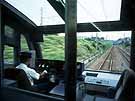
A front view from Super View Odoriko
By Oliver Mayer, September 1995
By Oliver Mayer
Look through the front window and feel like a train driver while
sitting comfortably in your seat! That's the best way to experience the
Japanese rail system. Of course, many local trains offer that for you
too, often even cheaper. But there you have to stand, and the trains do
not run at high speeds. So take your seat in one of the comfortable
express trains, and enjoy the journey.
This article lists many (I hope all, but I cannot confirm) express
trains and some slower trains, that offer a panorama car just behind
(or above or below) the driver, so that you can see all signals along
the route and the actions of the driver.
For many trains, these cars are Green cars (we would call it first
class) only. When traveling with a JR Pass, you should think about
getting a Green pass, which is only about 9,000 yen for one week or
18,000 yen for three weeks more than a normal pass. Normal JR Green
surcharges start with 750 yen for a local or rapid train up to 50 km,
but for express trains (tokkyu) the minimum is 1,240 yen and can go up
to 7,740 yen for a trip of more than 800 km.

Izukyu-Shimoda bound class 251 Super View Odoriko pulling into Ofuna station. |

A front view from Super View Odoriko |
This list uses the following abbreviations:
P panorama car, with the car number G Green car R reserved standard car (with car number) U unreserved standard car (with car number) for gives the direction of travel
JR panorama trains
Tokyo or Shinjuku to Izukyu-Shimoda:
class 251: Super View Odoriko P 1 G for Izukyu-Shimoda P 10 R for Tokyo/Shinjuku
Trains make the trip from Tokyo or Shinjuku (some start even in
Ikebukuro) via the Tokaido main line every one or two hours, with the
old Odoriko trains (class 185) in between. I took the Super View
Odoriko in 1994 from Shinjuku to Ito (so only using the JR section;
between Ito and Izukyu-Shimoda it is the private Izu Kyuko), and it was
a wonderful journey. Traveling over the Yamanote freight line from
Shinjuku southwards (which at that time was freight only) was
fascinating, as well as the journey along the Yokosuka-line tracks
under the Shinkansen. Trains from Shinjuku stay on the Yokosuka-line
tracks until Ofuna, while the trains from Tokyo are on the tracks of
the Tokaido Main line from the start.
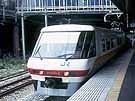
Class 381 Super Kuroshio at Shinosaka |
class 283: Ocean Arrow
class 381: Super KuroshioP 1 G for Shingu
Another fascinating trip, this time over the Osaka loop line. The
Super View Odoriko just goes parallel to the Yamanote tracks, while
these two trains go over the same tracks the local trains use in Osaka.
You sit comfortably in your Green seat and see crowded platforms in the
rush-hour pass by. Most trains start in Kyoto, then stop at Shinosaka
and go past Osaka station on a single track through the old freight
yard, before joining the loop line at Fukushima. They stop again in
Tennoji and then continue on the Hanwa-line. This line is heavily used,
and here again you can often see yellow or red signals in front of you.
Your train approaches yellow signals without reducing its speed, and
just a few meters before it would have to stop, the signal turns green
again. What a superb timetable!
Okayama to Izumo-shi:
class 381: Super Yakumo P 1 G for Izumo-shi
Note, that not all Super Yakumos have a panorama car, some just have
a normal Green car at the front. A ride in the Super Yakumo from
Okayama through the Chukoku mountains to the coast of Japan to Matsue
or Izumo-shi, one centre of the Japanese Shinto religion, takes you
through narrow valleys with this tilting train.
Nagoya to Nagano:
class 383: Shinano P 1 G for Nagano
The route goes through a narrow valley for a long time, and the
tilting is not very soft. Before reaching Nagano, you have a great view
over the Nagano plain. Class 381s with a panorama car used to run on
this route until 1996 and still appears on occasional workings. They
had the entrance in the middle of the car, so forming two small
sections.
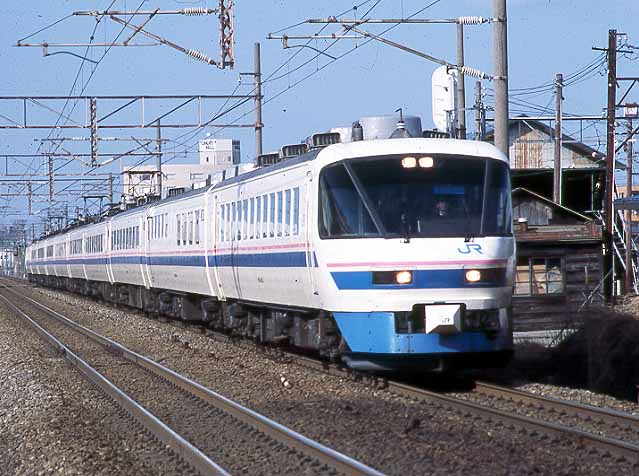
Class 485 Super Richo at Fukui-Guchi on the Hokuriku Main Line. |

A front view from Super Richo |
class 485: Super Raichoi (or Raicho only) P 1 G for Osaka
The Super Raicho runs with refurbished 485s, while the panorama
Green cars are actually 481s, some of them converted from 489s since
1987. The highlight of this route is the single track spiral tunnel
between Tsuruga and Shin-Hikida, I enjoyed it during my one-week Green
pass in 1995.
Hakata to Kumamoto or Nagasaki or Miyazaki
class 783: Ariake, Kamome, Nichirin P 1 G for Kumamoto (Ariake) P 1 G for Nagasaki (Kamome) P 1 G for Miyazaki (Nichirin) U, 4, 5, 6, 7 or 10, for Hakata (smoking)
783s are running on several services in Kyushu, and are especially
on the Kamome-service to Nagasaki often mixed with other classes. They
are however normally classified as running as "Hyper Saloon" in the
timetable. Officially they do not have a real panorama car, but you can
look out from both ends. The end facing Hakata is always unreserved,
the car number varies according to the length of the train. On the
Nichirin service, trains run between Hakata and Kokura with the Green
car facing backwards. All routes are interesting, although the trip to
Nagasaki may be the best of all.
Okayama to Takamatsu:
class 213: Marine Liner P 1 G to Takamatsu
The trip over the great Seto-Ohashi (Seto Bridge) can be enjoyed
best in the Green car facing Takamatsu, I have done it at least three
times. You can turn the seats around to have a better view. The Marine
Liner is no express (tokkyu), but a rapid (kaisoku), and therefore the
Green surcharge is only 950 yen and that means that you can use it with
your normal JR Railpass and paying only the Green car supplement.
Nagoya to Takayama/Toyama or Kii-Katsuura
class 85 (diesel): Hida or Nanki R 1 to Nagoya (Hida) R 10 to Toyama or U 5 to Takayama (Hida) G 1 to Kii-Katsuura (Nanki) U 4 to Nagoya (Nanki)
The class 85 on the Hida service has the Green car in the centre of
the train, so here the standard seats are the better ones. The route
goes through the Japanese Alps with nice views of the landscape. Note
that the train runs vice-versa between Nagoya and Gifu. The trains that
go through to Toyama have cars no. 8 to 10, the short runs between
Nagoya and Takayama have only cars no. 1 to 5 (cars 6 and 7 do not
exist).
The Nanki has a Green car for a lookout, but also on all the other
ends of Nanki or Hida, you can see out quite well. Class 85 is also
used for the morning-liner services in the rush-hour.
Shin-Osaka to Tottori
Edel (class unknown, diesel) P 1 R for Tottori P 4 R for Shin-Osaka
One of the few panorama trains I have not yet tried, so I do not
even know the train series. It has rather small panorama compartments
at both ends, and no Green car at all. On some days, the train may have
no panorama cars at all. The same vehicles are also used for similar
services in the Fukuchiyama area.
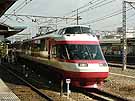
Odakyu class 10000 Romance Car at Odawara |
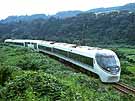
JR Tokai class 371 New Asagiri on the JR Gotemba Line |
Odakyu
class 3100, 7000, 10000: Romance Car
class 20000: Asagiri (Shinjuku - Numazu)
The Odakyu is one of the most famous companies known for their panorama
cars since 1963. Especially the classes 3100, 7000 and 10000, the true
Romance Cars with their driver in the small cab above the passengers,
are very popular. The seats directly behind the driver may be sold out
long before. The trains run from Shinjuku to Fujisawa, Odawara or
Hakone-Yumoto. The Asagiri-service is operated by either Odakyu 20000
or JR Tokai 371, of which the Odakyu stock is more interesting.
Traveling in a panorama seat along a line like the Odakyu with its
heavy traffic (and the massive construction going on now to extend the
line to four tracks) is a wonderful experience. Try not to take class
30000 EXE, as this is far from the Romance Car feeling, and the view
through the front window is not so good.
Nankai
class 30000: Koya (Namba - Gokurakubashi)
class 30000: Rinkan (Namba - Hashimoto)
Nankai is well known for the Rapi:t, but that one has no panorama end.
But on the other large line of Nankai, the Koya-line, there is the
class 30000, from which you can look out at both ends. The speed on the
Koya-line is rather slow with the trains rarely exceeding 90 km/h.
Kintetsu
class 26000: Sakura Liner (Abenobashi - Yoshino)
In the large Kintetsu network, only the Sakura Liner has good panorama
seats, although you can see something in many other trains, too. But
there is often a door at the end of a train, and then the view from the
seats next to the cab is obstructed. The class 23000 (Ise Shima Liner)
has no seats behind the cab, but a special standing zone for watching
the driver's actions and the track.
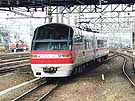
Meitetsu class 1000 Panorama Super pulling in JR Toyohashi station
|
In 1961, two years before Odakyu, Meitetsu started its Panorama Car
service. The trains were the class 7000, with the characteristic design
of the driver in a small cab above the passengers. The class 7000 is
still in service, but not anymore on the tokkyu-services, but on local
and rapid services without supplement and without the possibility to
make a reservation. In 1984, Meitetsu introduced the class 8800 as
"Panorama DX", and that was followed by class 1000 "Panorama Super" in
1988. In the two new trains you sit over the driver, and you have a
superb view; the train's speed is shown too. The class 1000 is one of
my all-time favorites.
Panorama Super trains run on the Nagoya Main line from Shin-Gifu to
Toyohashi, but only the end facing Toyohashi has a panorama car.
Shorter trains, but with panorama view on both ends, run from Nagoya to
Shin-Unuma via Inuyama, and at the other end of the system to Kowa,
Utsumi and Tokoname. Panorama DX trains run on the line from Saya to
Kira-Yoshida. The supplement for all Meitetsu-tokkyu is only 350 yen,
among the cheapest in Japan. Whenever possible, try to reserve!
Chizu Kyuko
class 7000: Super-Hakuto (Kyoto - Kurayoshi) U 1 for Kurayoshi (smoking) R 5 (sometimes 6) for Kyoto
A new third-sector railway, the diesel trains reach 120 km/h on JR
tracks and 125 km/h on the new Chizu tracks. The cabs are unusually
spacious. Kyoto to Kamigo and Chizu to Kurayoshi is JR, so that can be
used with a JR Pass (although I once went from Kyoto to Tottori in the
unreserved car without paying for the Chizu Kyuko section). Another
wonderful train ride, especially along the Tokaido/Sanyo-line through
Osaka and Kobe. The trains use the same tracks as the shin-kaisoku new
rapid and the freight trains.
Izu Kyuko
class 2100: Resort 21 (Atami - Izukyu-Shimoda)
A true panorama train, not only at both ends, but also in the normal
cars, where you have large windows (one side!) to enjoy the sea. Some
trains go to Tokyo on the same route as the Odoriko.